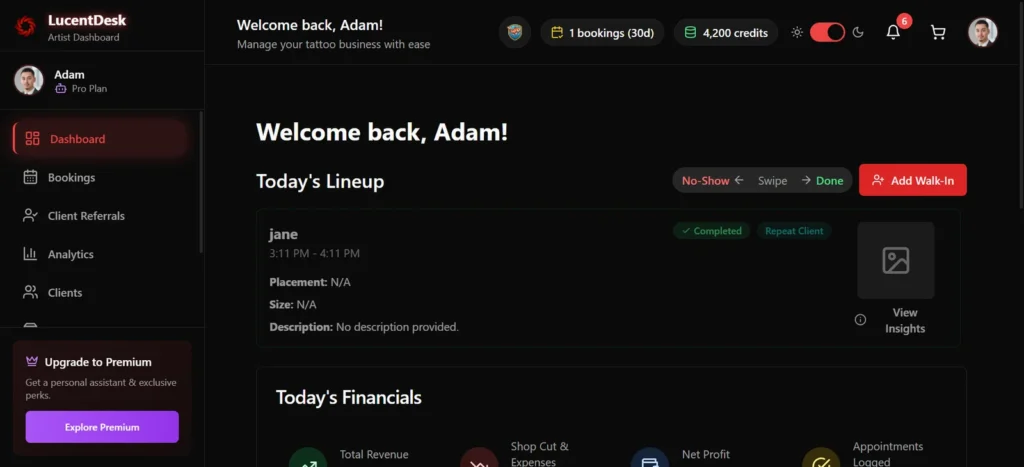The Tattoo Market Shift 2025 is reshaping how artists attract and keep clients. With rising competition and changing expectations, solo artists need smarter systems to stay fully booked. The good news? You don’t need a studio front desk—digital tools and tattoo booking apps give independent artists the same edge.
Tattoo Market Shift 2025: What the Data Shows
- The global tattoo market was valued at about USD 2.22 billion in 2024, and it’s projected to grow to USD 2.43 billion in 2025, with continued strong growth through 2032.
- But growth doesn’t mean it’s easy: according to The Tattoo Market in 2025: Understanding the Industry Shift, visibility is harder, bookings are down, and solo artists and small shops are feeling the squeeze amid oversaturation.
- One of the biggest challenges cited by tattoo artists is keeping up with technology, client expectations, and making their operations efficient amidst rising competition.
These stats show that while demand is still growing overall, the business side of tattooing is shifting: clients expect convenience, professional systems, and reliability.
How the Tattoo Market Shift 2025 Impacts Solo Artists
Here are key changes you can make now to adapt to the market shift:
- Upgrade Your Booking System
Clients expect fast, professional booking. A tattoo booking app or free tattoo booking app that works 24/7 can help you accept tattoo booking online instead of depending on DMs or phone calls. - Enforce Deposits & Clear Policies
With more artists vying for fewer clients in some markets, artists can’t afford no-shows and last-minute cancellations. Enforce policies (deposits, rescheduling rules) using tools that automate this so you don’t have to chase payments or negotiate manually. - Use Scheduling & Calendar Syncing
A tattoo scheduling app with calendar sync (personal + professional) keeps your tattoo appointment book in order. This avoids double-bookings and ensures you can balance your work and rest time. - Polished Communication = Trust
Clients are more discerning. They prefer booking systems that seem professional (clear confirmations, automated reminders, etc.) over informal DMs that may come across as less reliable. - Lean on Tools for Efficiency
Investing time in digital tools is investing in sustainability. Features like virtual numbers, auto-responses, reminders, deposit handling, and policy enforcement help you protect your time, reduce admin, and focus more on what you love: tattooing.
LucentDesk: Built for Tattoo Market Shift 2025
If you want a concrete tool to make these changes, LucentDesk is built as a solution for artists dealing with this very shift:
- It acts like a free tattoo booking app that offers policy enforcement, automatic deposit collection, and virtual number/text booking so clients can book via text or link rather than endless DMs.
- LucentDesk keeps all your tattoo schedule app features organized in one place (appointment book, calendar sync, reminders).
- Because it handles the booking & policy side smoothly, you avoid wasted time and protect slots, even when demand fluctuates.
If you’re thinking of upgrading your systems, you can check LucentDesk’s pricing & plans here.

Examples & Proof from the Field
- Friction in booking = lost business: A survey of salons and spas with >1,000 respondents found that 71% skip booking if it’s too hard to reach the business or use the online system.
- Digital convenience expected: More and more consumers across industries (retail, services, wellness) are choosing businesses that offer quick, online, easy-to-use booking and communication tools.
- Market growth with pressure: Even though the tattoo market is forecasted to grow, small shops are under pressure to professionalize just to keep up with changing expectations.
What This Means for Your Tattoo Booking Strategy
- Prioritize reducing friction: the smoother the booking, the more bookings you’ll keep.
- Automate as much of the client journey as possible: booking → policy/deposits → reminders → calendar sync.
- Use tools to appear bigger and more professional than your size might suggest. Clients don’t know (and don’t care) how many artists you have—they do notice how organized you are.
- Do regular reviews: track how many inquiries convert to booked appointments, how many no-shows, and what barriers clients mention. Adjust policies accordingly.
Moving Forward: Next Steps
- Audit your current booking process: where are clients dropping off? What takes you too long?
- Try using LucentDesk (or another app) for free booking online, with policies, calendar sync, etc.
- Communicate clearly with clients about deposits, schedules, booking by text/online, etc. Use your platforms (Instagram, TikTok, email) to let people know how easy it now is.
- Collect feedback from clients about booking experience, adjust where needed.
The tattoo market shift in 2025 is pushing solo artists to adopt more professional, frictionless booking strategies. Demand is still growing, but expectations are higher. If you want to keep growing, protect your time, and stand out, you need systems—not just talent. Using tools like LucentDesk, enforcing policies, automating reminders, and offering easy online/text booking will help you stay ahead.

